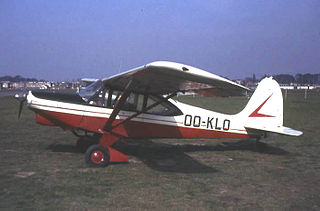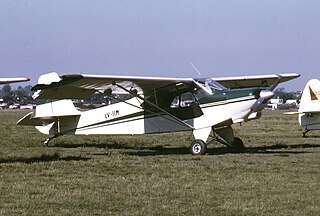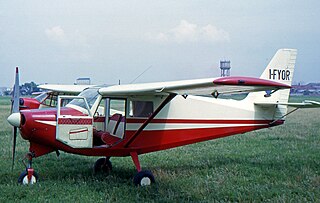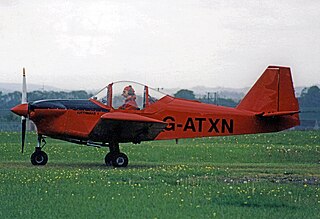
The Sequoia Falco is an Italian-designed lightweight 2-seater aerobatic aircraft.

The ACBA Midour, Midour 2 and Midour 3 are a series of glider tugs manufactured by the Aéro Club du Bas Armagnac in France, and named after the Midou River.

The Aero Commander 100, various models of which were known as the Darter Commander and Lark Commander was an American light aircraft produced in the 1960s. It was a high-wing monoplane of conventional design, equipped with fixed tricycle undercarriage.
The AISA GN was a prototype four-seat autogyro developed in Spain between 1971 and 1982. it featured an extensively-glazed cabin fitted with a pusher engine and tricycle undercarriage. A separate tail fin was carried at the end of two booms mounted to stub wings. The prototype was developed with a 200 hp engine. The aircraft suffered from an extremely prolonged development, but finally took to the air on 20 July 1982. Shortly thereafter, however, it was damaged and finally abandoned.

The Boisavia B.60 Mercurey was a series of four-seat light aircraft developed in France shortly after World War II.

The Pützer Elster was a German single-engined light aircraft, manufactured by Alfons Pützer KG in Bonn. It served with the Luftwaffe and Marineflieger and was used solely for recreational sport flying. Some continue to fly in 2020 in private ownership.

The Robin DR400 is a wooden sport monoplane, conceived by Pierre Robin and Jean Délémontez. The Robin DR400 first flew in 1972 and is still in production. The current model is designated 'DR401'. It has a tricycle undercarriage and can carry four people. The DR400 has a 'cranked wing' configuration, with the dihedral angle of the outer wing much greater than the inboard, a configuration which they share with Jodel aircraft. This model is considered easy to fly by many and quiet during flight due to its wooden frame.

The DINFIA IA 46 Ranquel, IA 46 Super Ranquel, and IA 51 Tehuelche were Argentine utility aircraft developed in the late 1950s.

The Hoffmann H40 was a prototype sport aircraft built in Germany in 1988. Designed by Wolf Hoffmann based on his Dimona motor-glider, it was a conventional, low-wing monoplane with side-by-side seating for two and tricycle undercarriage. The aircraft's high aspect ratio wings and T-tail were carried over from its motorglider heritage, but the span was shorter than that of the Dimona. Construction throughout was of composite materials. Hoffmann intended this aircraft to compete with sporting two-seaters such as the Grob G 115 and Robin ATL, but was unable to find the financial backing to bring the aircraft to market, despite a 30% share bought in the project by German pump manufacturer ABS.

The IAR-824 was a utility aircraft built in Romania in the 1970s.

The Partenavia P.57 Fachiro is an Italian, four-seat, high-wing, touring monoplane, fitted with a fixed tricycle undercarriage.

The GY-80 Horizon is a French four-seat touring monoplane of the 1960s designed by Yves Gardan and built under licence, first by Sud Aviation, and later by that company's SOCATA subsidiary.

The PIK-15 Hinu was a light aircraft developed in Finland in the 1960s for use as a glider tug. It was a low-wing cantilever monoplane of conventional design with an enclosed cockpit and fixed, tailwheel undercarriage. The cockpit had two seats, side-by-side, and the PIK-15 was intended to have a secondary role as a trainer. Construction was of wood throughout.

The Spencer Amphibian Air Car is an American light amphibious aircraft. The name was first used in 1940 for a prototype air vehicle that developed into the Republic Seabee. The name was later used by its designer Percival Spencer for a series of homebuilt amphibious aircraft roughly based on the Seabee design.

The Ambrosini Rondone is an Italian-designed two/three-seat light touring monoplane of the early 1950s.

The SAN Jodel D.140 Mousquetaire (Musketeer) is a French five-seat light touring monoplane based on the earlier Jodel D.117 and built by Société Aéronautique Normande (SAN) at Bernay.

The Mitchell Kittiwake is a British single engine sporting aircraft designed for amateur building. Plans were available for both single-seat and two-seat versions, but only four were constructed.

The Dyn'Aéro CR.100 is a French kit built single engine, two-seat monoplane, developed in the 1990s and intended as both an aerobatic trainer and a tourer, primarily for aero club use.

The Aeronca K series, Aeronca Chief, Aeronca Super Chief, Aeronca Tandem, Aeronca Scout, Aeronca Sea Scout, Aeronca Champion and Aeronca Defender were a family of American high-winged light touring aircraft, designed and built starting in the late 1930s by Aeronca Aircraft.

The Aviamilano F.14 Nibbio is a four-seat, single engine cabin monoplane built in Italy in the late 1950s. Only ten production aircraft were completed.



















